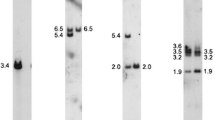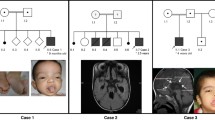Abstract
The gene for the X-linked Kallmann syndrome (KAL), a developmental disorder characterized by hypogonadotropic hypogonadism and anosmia, maps to Xp22.3 and has a homologous locus, KALP, on Yq11. We show here that KAL consists of 14 exons spanning 120-200 kilobases that correlate with the distribution of domains in the predicted protein including four fibronectin type III repeats. The KALP locus reveals several large deletions and a number of small insertions, deletions and base substitutions which indicate it is a non-processed pseudogene. The sequence divergence between KAL and KALP in humans, and the chromosomal location of KAL homologous sequences in other primates, suggest that KALP and the steroid sulphatase pseudogene on Yq11 were involved in the same rearrangement event on the Y chromosome during primate evolution.
Similar content being viewed by others
References
Maestre de San Juan, A. Falta total de los nervios olfactories con anosmia en un individuo en quien existia una atrofia congénita de los testiculos y miembro viril. Siglo Medico 131, 211 (1856).
Kallmann, F.J., Schoenfeld, W.A. & Barrera, S.E. The genetic aspects of primary eunuchoidism. Am. J. ment. Def. 48, 203–236 (1944).
Sparkes, R.S., Simpson, R.W. & Paulsen, C.A. Familial hypogonadotropic hypogonadism with anosmia. Arch. intern. Med. 121, 534–538 (1968).
Jones, J. & Kemmann, E. Olfacto-genital dysplasia in the female. Obstet. Gynecol. Annu. 5, 443 (1976).
McKusick, V. Mendelian inheritance in man. Catalogs of autosomal dominant, autosomal recessive, and X-linked phenotypes. (Johns Hopkins University Press, Baltimore, 1990).
Ballabio, A. et al. Deletions of the steroid sulfatase gene in classical X-linked ichthyosis and in X-linked ichthyosis associated with Kallmann syndrome. Hum. Genet. 77, 338–341 (1987).
Legouis, R. et al. The candidate gene for the X-linked Kallmann syndrome encodes a protein related to adhesion molecules. Cell 67, 423–435 (1991).
Franco, B. et al. A gene deleted in Kallmann's syndrome shares homology with neural cell adhesion and axonal path-finding molecules. Nature 353, 529–536 (1991).
Bick, D. et al. Intragenic deletion of the KALIG-1 gene in Kallmann's syndrome. New Engl. J. Med. 326, 1752–1755 (1992).
Hardelin, J.-P. et al. X chromosome-linked Kallmann syndrome: Stop mutations validate the candidate gene. Proc. natn. Acad. Sci. U.S.A. 89, 8190–8194 (1992).
De Morsier, G. Etudes sur les dysraphies crånio-encéphaliques. Schweiz Arch. neurol. Psychiat. 74, 309–361 (1954).
Males, J.L., Townsend, J.L. & Schneider, R.A. Hypogonadotropic hypogonadism with anosmia-Kallmann's syndrome. Arch. intern. Med. 131, 501–507 (1973).
Schwanzel-Fukuda, M. & Pfaff, D.W. Origin of luteinizing hormone-releasing hormone neurons. Nature 338, 161–164 (1989).
Wray, S., Grant, P. & Gainer, H. Evidence that cells expressing luteinizing hormone-releasing hormone mRNA in the mouse are derived from progenitor cells in the olfactory placode. Proc. natn. Acad. Sci. U.S.A. 86, 8132–8136 (1989).
Ronnekleiv, O.K. & Resko, J.A. Ontogeny of gonadotropin-releasing hormone-containing neurons in early fetal development of Rhesus macaques. Endocrinology 126, 498–511 (1990).
Schwanzel-Fukuda, M., Abraham, S., Crossin, K.L., Edelman, G.M. & Pfaff, D.W. Immunocytochemical demonstration of neural cell adhesion molecule (NCAM) along the migration route of luteinizing hormone-releasing hormone (LHRH) neurons in mice. J. comp. Neurol. 321, 1–18 (1992).
Schwanzel-Fukuda, M., Bick, D. & Pfaff, D.W. Luteinizing hormone-releasing hormone (LHRH)-expressing cells do not migrate normally in an inherited hypogonadal (Kallmann) syndrome. Molec. brain Res. 6, 311–326 (1989).
Dear, T.N. & Kefford, R.F. The WDNM1 gene product is a novel member of the ‘four-disulphide Core’ family of proteins. Biochem. Biophys. Res. Commun. 176, 247–254 (1991).
Monard, D. Cell-derived proteases and protease inhibitors as regulators of neurite outgrowth. Trends Neurosci. 11, 541–544 (1988).
Engel, J. Common structural motifs in proteins of the extracellular matrix. Curr. Opin. Cell Biol. 3, 779–785 (1991).
Petit, C., Levilliers, J. & Weissenbach, J. Long-range restriction map of the terminal part of the short arm of the human X chromosome. Proc. natn. Acad. Sci. U.S.A. 87, 3680–3684 (1990).
Yen, P.H. et al. The human X-linked steroid sulfatase gene and a Y-encoded pseudogene: evidence for an inversion of the Y chromosome during primate evolution. Cell 55, 1123–1135 (1988).
Shapiro, L.J., Mohandas, T., Weiss, R. & Romeo, G. Non-inactivation of an X-chromosome locus in man. Science 204, 1224–1226 (1979).
Senapathy, P., Shapiro, M.B. & Harris, N.L. Splice junctions, branch point sites, and exons : sequence statistics, identification, and applications to genome project. Meth. Enzymol. 183, 252–278 (1990).
Albertsen, H.M. et al. Construction and characterization of a yeast artificial chromosome library containing seven haploid human genome equivalents. Proc. natn. Acad. Sci. U.S.A 87, 4256–4260 (1990).
Stetler, G., Brewer, M.T. & Thompson, R.C. Isolation and sequence of a human gene encoding a potent inhibitor of leucocyte proteases. Nucl. Acids Res. 14, 7883–7896 (1986).
Campbell, S.M. & Rosen, J.M. Comparison of the whey acidic protein genes of the rat and mouse. Nucl. Acids Res. 12, 8685 (1984).
Thepot, D., Devinoy, E., Fontaine, M.L., Hubert, C. & Houbedine, L.M. Complete sequence of the rabbit whey acidic protein gene. Nuc. Acid. Res. 18, 3641 (1990).
Oldberg, A. & Ruoslahti, E. Evolution of the fibronectin gene. J. biol. Chem. 261, 2113–2116 (1986).
Dynan, W.S. & Tjian, R. Control of eukaryotic messenger RNA synthesis by sequence-specific DNA-binding proteins. Nature 316, 774–778 (1985).
Rouyer, F. et al. A gradient of sex linkage in the pseudoautosomal region of the human sex chromosomes. Nature 319, 291–295 (1986).
Yen, P.H., Ellison, J., Salido, E.C., Mohandas, T. & Shapiro, L. Isolation of a new gene from the distal short arm of the human X chromosome that escapes X-inactivation. Hum. molec. Genet. 1, 47–52 (1992).
Salido, E.C., Yen, P.H., Koprovnikar, K., Yu, L.-H. & Shapiro, L.J. The human enamel protein gene amelogenin is expressed from both the X and the Y chromosomes. Am. J. hum. Genet. 50, 303–316 (1992).
Schneider-Gädicke, A. et al. ZFX has a gene structure similar to ZFY, the putative human sex determinant, and escapes X inactivation. Cell 57, 1247–1258 (1989).
Fisher, E.M.C. et al. Homologous ribosomal protein genes on the human X and Y chromosomes: escape from X inactivation and possible implications for Turner syndrome. Cell 63, 1205–1218 (1990).
Migeon, B. et al. Differential expression of steroid sulphatase locus on active and inactive human X chromosome. Nature 299, 838–840 (1982).
Keitges, E., Rivest, M., Siniscalco, M. & Gartler, S.M. X-linkage of steroid sulphatase in the mouse is evidence for a functional Y-linked allele. Nature 315, 226–227 (1985).
Huynh, T.V., Young, R.A. & Davis, R.W. in DNA cloning: a practical approach vol. 1 (ed. Glover, D.M.) 49–78 (IRL, Oxford, 1985).
Sambrook, J., Fritsch, E.F. & Maniatis, T. Molecular cloning. A laboratory manual. (Cold Spring Harbor Laboratory, New York, 1989).
Dessen, P., Fondrat, C., Valencien, C. & Mugnier, C. BISANCE: A French service for access to biomolecular sequence databases. CABIOS 6, 355–356 (1990).
Lemeslevarloot, L. et al. Hydrophobic Cluster Analysis-Procedures to derive structural and functional information from 2–D representation of protein sequences. Biochimie 72, 555–574 (1990).
Thoreau, E., Petridou, B., Kelly, P.A. & Mornon, J.P. Structural symmetry of the extracellular domain of the cytokine/growth hormone/prolactin receptor family and interferon receptors revealed by hydrophobic cluster analysis. FEBS Lett. 282, 26–31 (1991).
Nelson, D.L. et al. Alu polymerase chain reaction : a method for rapid isolation of human-specific sequences from complex DNA sources. Proc. natn. Acad. Sci. U.S.A. 86, 6686–6690 (1989).
Krueger, N.X. et al. Structural diversity and evolution of human receptor-like protein tyrosine phosphatases. EMBO J. 9, 3241–3252 (1990).
Hemperly, J.J., Murray, B.A., Edelmann, G.M. & Cunningham, B.A. Sequence of a cDNA clone encoding polysialic acid-rich and cytoplasmic domains of the neural cell adhesion molecule N-CAM. Proc. natn. Acad. Sci. U.S.A. 83, 3037–3041 (1986).
Moos, M. et al. Neural adhesion molecule L1 as a member of the immunoglobulin superfamily with binding domains similar to fibronectin. Nature 334, 701–703 (1988).
Author information
Authors and Affiliations
Rights and permissions
About this article
Cite this article
del Castillo, I., Cohen-Salmon, M., Blanchard, S. et al. Structure of the X–linked Kallmann syndrome gene and its homologous pseudogene on the Y chromosome. Nat Genet 2, 305–310 (1992). https://doi.org/10.1038/ng1292-305
Received:
Accepted:
Issue Date:
DOI: https://doi.org/10.1038/ng1292-305
- Springer Nature America, Inc.
This article is cited by
-
Mutation spectrum of Kallmann syndrome: identification of five novel mutations across ANOS1 and FGFR1
Reproductive Biology and Endocrinology (2023)
-
X-linked recessive ichthyosis in 8 Tunisian patients: awareness of misdiagnosis due to the technical trap of the STS pseudogene
BMC Medical Genomics (2022)
-
Unbalanced X;9 translocation in an infertile male with de novo duplication Xp22.31p22.33
Journal of Assisted Reproduction and Genetics (2019)
-
Molecular analysis of KAL-1 in a series of Kallmann syndrome and normosmic idiopathic hypogonadotropic hypogonadism patients from Northwestern China
Asian Journal of Andrology (2009)
-
Can Kallmann syndrome be occasionally diagnosed during childhood? Genetic diagnosis in a child with associated renal agenesis and mirror movements
Asian Journal of Andrology (2009)





